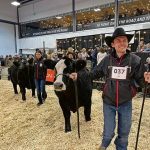The ongoing cattle herd liquidation in Canada over the past few years may be starting to slow down, but it will take a number of years before the herd reduction trend turns around and a noticeable increase in the herd size could be expected, according to industry analysts.
Brenna Grant, a research analyst with Canfax, the market analysis division of the Canadian Cattlemen’s Association, pointed to government statistics showing that Canada’s beef cattle herd peaked in 2005 and has since declined 20 per cent since that time. “Our beef cow inventories are now the smallest since 1994,” said Grant.
Read Also

U.S. grains: Soybeans tumble on doubts over U.S.-China trade progress
Chicago Board of Trade soybean futures plummeted on Friday as trade restrictions announced by China and escalating rhetoric from U.S. President Donald Trump cooled hopes of a resolution to a standoff between Washington and Beijing.
Cow marketings in 2010 were moderately smaller than the previous year, she said, but noted the herd size is still expected to be smaller in the upcoming Statistics Canada report.
Statistics Canada releases official estimates on the country’s cattle inventories as of Jan. 1, on Feb. 17.
The decision to reduce herd sizes further will come down to each individual operation, and their profitability, Grant said. “Are they in a position to expand, or will they take the money and run, with these higher cow prices?
“On the one hand, you have high cow prices which are encouraging producers to be very critical in their culling decisions,” said Grant. “They are able to remove some of those older, less productive cows, retain more heifers, and replace genetics.”
At the same time, feeder prices are also high and may be causing some producers still looking to exit the business to sell those animals that they otherwise would have retained for their herd.
“Looking to 2011, we are expecting cow marketings to be smaller than previous years,” said Grant.
Depending on how aggressively producers retain heifers, 2011 could be a stabilizing year for the sector, said Grant. However, she noted, it would take at least two years for the beef industry to turn itself and see an increase in the herd.
Cattle analyst Herb Lock of FarmSense Marketing in Calgary said there was still no sign of herd rebuilding in the U.S., which means Canada is unlikely to rebuild right now either.
Lock said high feeder prices last fall likely led to more cattle that normally would have been added to the beef herd, sold to the feedyards instead.
“We’re almost a victim of our own success,” said Lock. “In spite of relatively high prices, we don’t expect to see much herd replacement.”
Feeder heifer calves that would be replacement-type are so far not bringing any premium in the auction yards, which indicates that people aren’t paying up for them, he said. “Even if we do hold them back this year, if the feeder prices get to high this fall, they’ll sell them.”
Many older producers are taking the opportunity to exit the industry at these highs, said Lock, which is providing other people with more opportunities to get replacement cattle. Those buyers don’t need to keep their own heifer calves, and can buy cows instead. As a result, the overall herd size doesn’t increase, even if some producers are expanding their operations.
Even if they do decide to hold some heifers back, Lock said, it will be a number of years before that results in an increase on the beef side.













